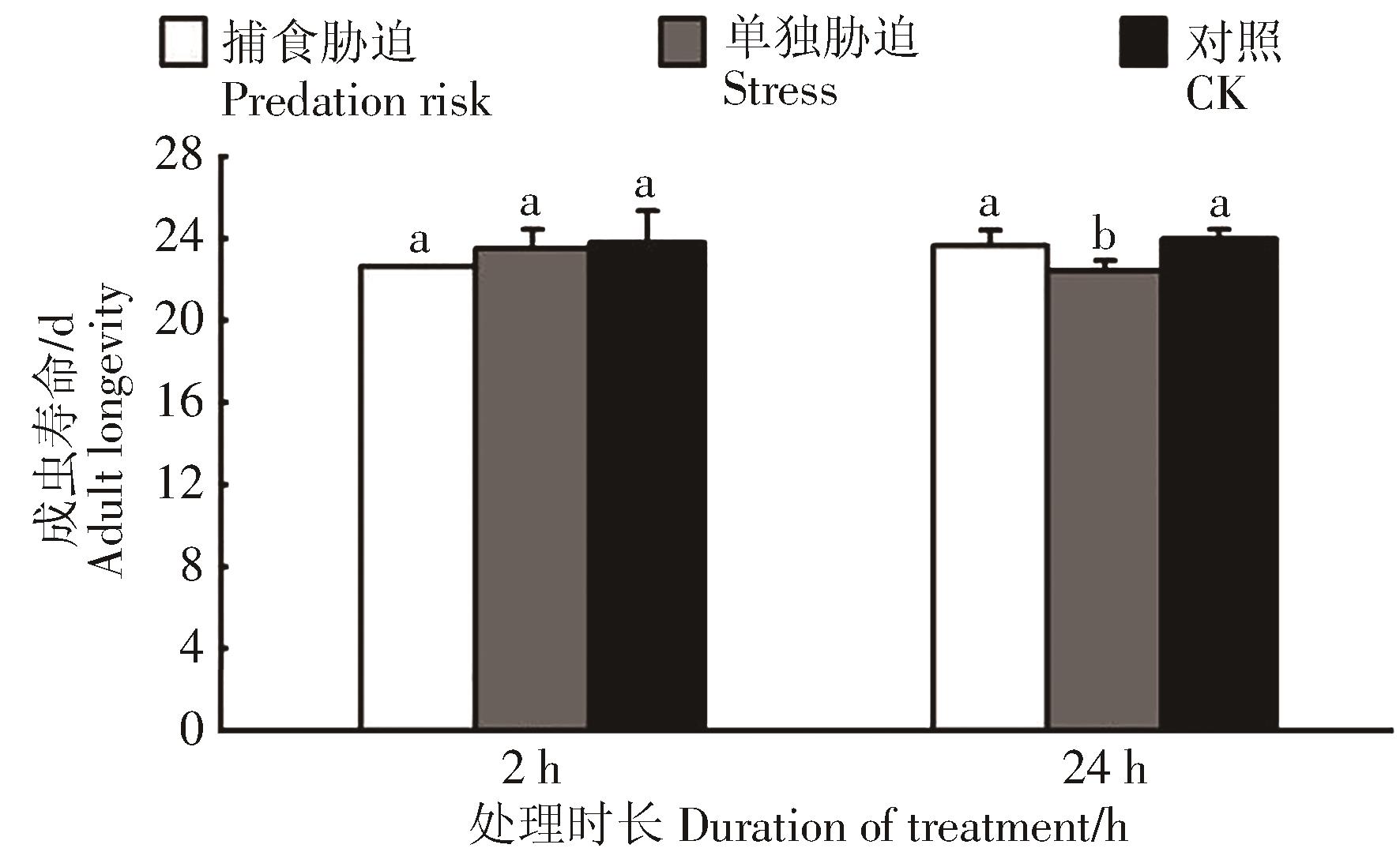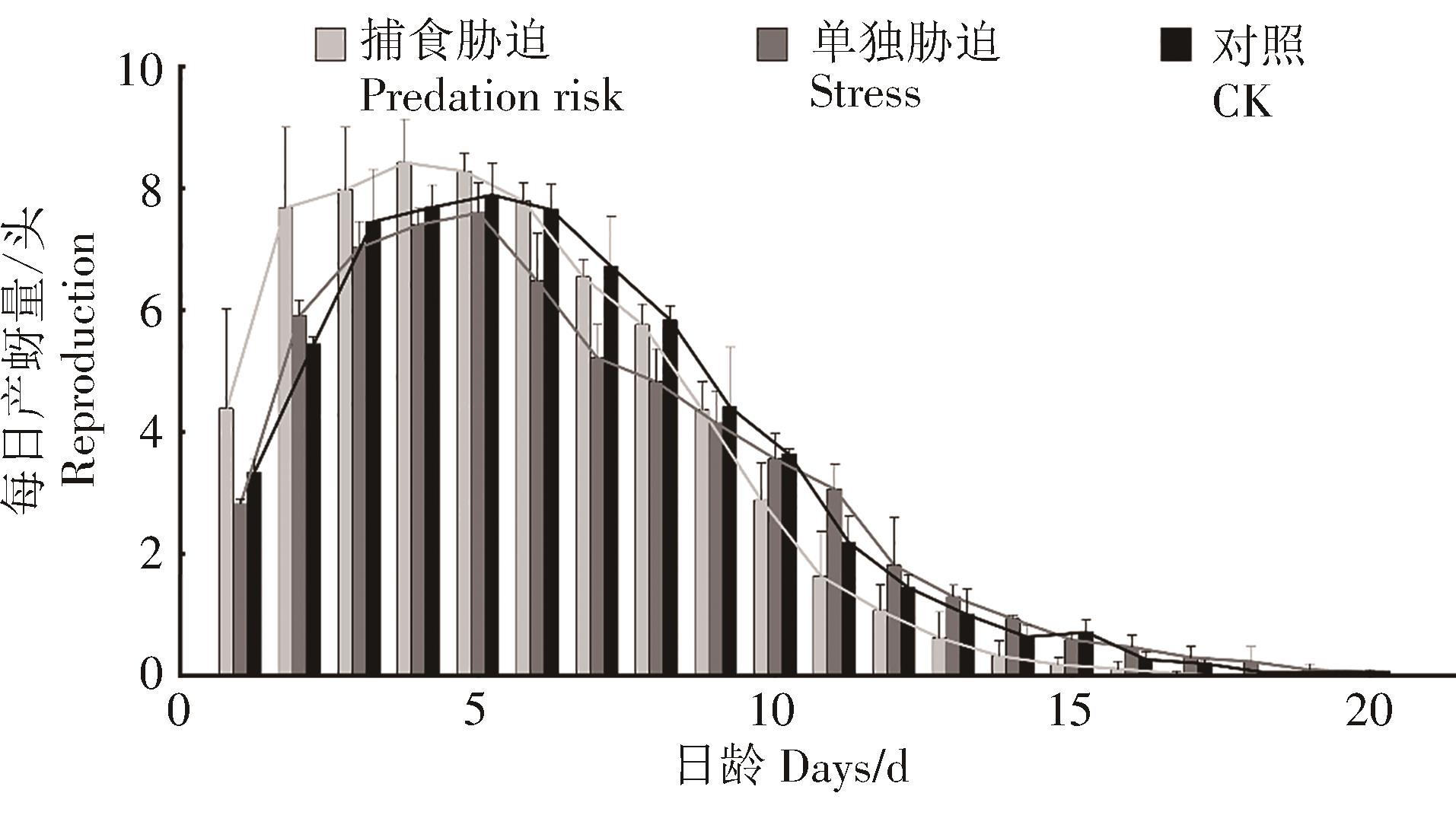-
主持人:廖卫国
海南地处热带、亚热带地区,温湿度、光照适宜,种植业方面具有得天独厚的优势。海南的蔬菜种植以冬季瓜菜为主,瓜类作物种植面积和产量均位居前列[1]。瓜蚜是瓜类作物生产中发生最为严重的害虫之一,其若蚜和成蚜刺吸为害幼嫩叶片、植物生长点,导致黄瓜等作物叶片萎缩、卷曲、变黄,出现生长缓慢、枯苗等现象,从而影响黄瓜苦瓜等瓜类作物的产量和品质,造成瓜类作物严重减产[2]。目前主要通过施用化学农药来对瓜蚜进行防治,但是农药长期使用导致蚜虫对多种药剂产生了抗性,其发生促使人们加大农药使用量和增加施药频次,这不仅导致用药成本上升,蚜虫抗性发展更快,而且导致农药残留严重,引发食品安全问题和生态安全问题[3]。生物防治是应用天敌控制害虫的重要手段[4]。传统上,生物防治主要通过天敌直接捕食(或寄生)害虫降低害虫种群数量。研究发现,除了直接捕食作用,天敌昆虫还能通过引发非直接捕食效应(胁迫效应)影响害虫行为、生理和生长发育,间接地降低害虫的适合度[5]。例如,天敌斑腹刺益蝽(Podisus maculiventris)胁迫使马铃薯甲虫(Leptinotarsa decemlineata)取食行为改变,取食量减少29%[6];七星瓢虫(Coccinella septempunctata)胁迫减少禾谷缢管蚜(Rhopalosiphum padi) 40%的定殖率[7]。异色瓢虫胁迫使棉铃虫(Helicoverpa armigera)幼虫和蛹的发育历期加快,其后代的繁殖能力和存活率也发生改变[8]。天敌昆虫的胁迫效应不仅可以影响当代猎物,对猎物的子代也会产生影响。李燕平等[9]的研究表明,龟纹瓢虫(Propylaea japonica)胁迫会影响连续三代黑腹果蝇(Drosophila melanogaster)的生长发育和繁殖。这些猎物行为、生长发育和繁殖的变化,最终会影响它们的种群数量[10-12]。六斑月瓢虫(Cheilomenes sexmaculata)属鞘翅目Coleoptera瓢虫科Coccinellidae,是我国南方农田中的重要天敌昆虫。Patel等[13]的研究结果显示,六斑月瓢虫在植物上留下的足部挥发物对墨西哥甲虫(Zygogramma bicolorata)有明显的胁迫作用,其胁迫显著改变了墨西哥甲虫的取食速率、物质转化效率和生长发育速率。本研究拟探究六斑月瓢虫对瓜蚜的胁迫作用,明确六斑月瓢虫胁迫对瓜蚜生长发育和繁殖的影响。研究结果将有助于全面了解六斑月瓢虫在蚜虫控制中发挥的作用。
HTML
-
瓜蚜:2020年3月采自海南大学海甸校区农科基地黄瓜田,在室内(26±1 ℃,光周期16 L:8 D)采用黄瓜苗继代饲养。挑取3日龄成蚜用于试验。
六斑月瓢虫:2018年12月采自海南大学海甸校区农科基地玉米田,将成虫带回室内饲养于罩笼中,以豆蚜饲喂。每天补充豆蚜,并收集卵块。将卵块置于培养皿中待其孵化,孵化后的幼虫采用豆蚜单头饲养至蛹期。待其羽化后转移回成虫罩笼中继续饲喂。挑选大小一致,活性良好的瓢虫3龄幼虫用于试验。
-
参考Hermann等[14]的胁迫试验装置,自制双层培养皿(d = 9 cm,h = 3 cm)(如图1所示)开展胁迫试验。试验装置包括最下层(c层),中间层(b层)和最上面的培养皿盖(a层),形成了a-b构成的上层胁迫空间(主要放置天敌昆虫)和b-c构成的下层空间(放置瓜蚜)。b层中央有1个4 cm×4 cm的正方形缺口并以纱布密封。
试验时,设置3个处理即捕食胁迫组,单独胁迫组和对照组。
(1)捕食胁迫组(Predation risk):在上层空间(a-b)上接入40头成蚜并放入1头六斑月瓢虫3龄幼虫,使瓢虫能直接捕食到蚜虫。下层空间(b-c)放入10头蚜虫。上层空间中的瓢虫在捕食瓜蚜过程中,瓢虫或瓜蚜散发的气味物质可以传递到下层空间。
(2)单独胁迫组(Stress):上层空间(a-b)放入1头六斑月瓢虫3龄幼虫,不放蚜虫,下层空间(b-c)放入10头瓜蚜。瓢虫无法捕食到蚜虫,但来自瓢虫的气味物质可以传递到下层空间。
(3)对照组(CK):上层空间(a-b)瓢虫和蚜虫都不放, 下层空间(b-c)放置10头瓜蚜。
各组试验处理中均在b层提供1个湿润棉球,为上层空间昆虫补充水分。上下两层空间设置完毕后,用封口膜把双层皿装置密封起来。为探究不同时长的胁迫对瓜蚜的影响,根据已有的研究[20,22]作为参考,试验设置2个胁迫时长2 h(短时) 和24 h(长时)。经过不同的处理时长后,马上分离上下层,并收集下层空间内的瓜蚜,用于开展生命参数测定。
-
采用叶碟法测定胁迫对瓜蚜生命参数的影响,试验在小培养皿(d = 3.5 cm,h = 1 cm)中进行。胁迫后的瓜蚜单头饲养于铺有黄瓜叶片的培养皿中,采用0.6%的琼脂培养基给瓜叶保湿。观察瓜蚜,待其产蚜并保留其所产若蚜1头,每重复均收集20~25头若蚜作为试虫,每试验组(共6组:2 h捕食胁迫、2 h单独胁迫、2 h对照组、24 h捕食胁迫、24 h单独胁迫、24 h对照组)分别设置3个重复。将各组若蚜单头饲养于瓜叶,并每2 d更换1次黄瓜叶片。同时,每24 h观察记录若蚜的龄期、记录若蚜的存活情况。当其成为成蚜后,每24 h观察并记录蚜虫的存活情况和产蚜量,并移去所产子代若蚜,直至所有成蚜死亡。将记录数据用于生命表参数的数据分析。
-
数据分析用IBM SPSS Statistics Package V.26.0(SPSS Inc., New York, USA)软件进行,利用单因素方差(one-way ANVOA,Tukey test)进行检验,P<0.05,分析各组间瓜蚜的成虫寿命、产蚜历期、总产蚜量、内禀增长率(Rm),净生殖率(R0)和平均世代时间(T)和周限增长率(λ)等生命表参数的差异。
-
六斑月瓢虫对瓜蚜的胁迫效果与胁迫时长有关,短时胁迫(2 h)对瓜蚜寿命没有明显影响(图2)。六斑月瓢虫长时胁迫(24 h)使子代瓜蚜成虫寿命比对照组显著缩短(F = 5.844,P = 0.039)。单独胁迫组子代瓜蚜寿命(22.44 d)和对照组相比(23.99 d)缩短了6.46%。捕食胁迫组中,子代瓜蚜寿命没有显著变化。
-
经历长时间(24 h)胁迫的瓜蚜产的子代的繁殖能力发生明显改变(图3)。捕食胁迫组和单独胁迫组的子代瓜蚜的产蚜历期均显著缩短(F = 10.307,P = 0.011),和对照组(13.02 d)相比,捕食胁迫组(11.49 d)缩短了11.75%,单独胁迫组(12.12 d)缩短了6.91%(图3-A)。六斑月瓢虫胁迫下子代瓜蚜的总产蚜量也显著下降(F = 23.717,P = 0.001),和对照组(64.25头)相比,捕食胁迫组(产蚜60.83头)下降5.32%,单独胁迫组(产蚜55.28头)下降了13.96%(图3-B)。短时胁迫(2 h)未对瓜蚜繁殖历期和产蚜量产生显著影响。

Figure 3. The reproductive period (A) and total aphid production(B) of Aphis gossypii under the predation risk or stress of Cheilomenes sexmaculata
六斑月瓢虫长时间(24 h)胁迫对瓜蚜子代每日产蚜量产生影响(图4)。图4显示,有胁迫经历的瓜蚜后代,在开始产蚜的初期,产蚜量明显高于对照,可见,瓢虫捕食胁迫促进了瓜蚜子一代的繁殖;但6 d后这种刺激作用明显降低,捕食胁迫组瓜蚜每日产蚜量低于对照组;单独胁迫组这种刺激作用不明显。
-
经六斑月瓢虫胁迫后的瓜蚜,其所产子代生命表参数变化如表1所示。短时胁迫(2 h)和长时间胁迫(24 h)对子代瓜蚜生命参数均有一定影响。经历2 h六斑月瓢虫胁迫后的瓜蚜,其所产子代内禀增长率(Rm)和周限增长率(λ)均显著降低(Rm:F = 9.003,P = 0.016;λ:F = 8.943,P = 0.016),其世代周期(T)和种群加倍时间(DT)均延长(T: F = 5.411,P = 0.045; DT: F = 9.269,P = 0.015)。经历瓢虫长时间胁迫(24 h)的瓜蚜,其所产子代瓜蚜的净增殖率(R0)显著减小(F=36.843,P = 0.0001),单独胁迫组和捕食胁迫组的R0均显著低于对照。
处理时长/hDuration of treatment 处理Treatment 净增殖率R0 内禀增长率Rm 世代周期T 种群加倍时间DT 周限增长率λ 2 捕食胁迫Preation risk 62.54±2.85 a 0.44±0.00 b 9.39±0.12 a 1.57±0.01 a 1.55±0.00 b 单独胁迫Stress 61.23±1.73 a 0.44±0.00 b 9.26±0.10 ab 1.56±0.01 a 1.56±0.00 b 对照CK 65.56±2.23 a 0.46±0.01 a 9.05±0.16 b 1.50±0.04 b 1.59±0.02 a 24 捕食胁迫Preation risk 60.83±0.91 b 0.47±0.02 a 8.83±0.36 a 1.49±0.06 a 1.59±0.03 a 单独胁迫Stress 55.57±2.03 c 0.44±0.01 a 9.07±0.13 a 1.57±0.03 a 1.56±0.02 a 对照CK 64.98±0.69 a 0.46±0.00 a 9.15±0.02 a 1.52±0.00 a 1.58±0.00 a 注: 数据为平均值±标准误,不同小写字母表示0.05水平上差异显著。Note: data were presented as mean±SD, data with different lowercase letters indicated significant difference at 0.05 level.Table 1. Population life table parameters of Aphis gossypii under predation risk or stress of Cheilomenes sexmaculata.
-
天敌对害虫的胁迫效应已在多种昆虫中报道[15-17],这种胁迫改变了昆虫的取食、产卵、定殖和扩散等行为,影响了害虫的生长发育和生理,降低害虫的适合度,从而使害虫的种群数量下降[18]。本研究也发现,除了直接捕食,六斑月瓢虫对瓜蚜有明显的胁迫作用,胁迫降低了瓜蚜的适合度。
天敌的胁迫能改变猎物的繁殖能力。例如,凡泽云[19]的研究中,经丽蚜小蜂(Encarsia formosa)胁迫的烟粉虱(Bemisia tabaci)若虫变为成虫后,产卵量显著下降;Hermann等[14]发现,经异色瓢虫(Harmonia axyridis)胁迫的桃蚜产蚜量显著下降,和对照相比下降了23%。当然,天敌胁迫不仅会对当代猎物产生影响,也会影响其后代。Venkanna等[20]发现,天敌胁迫使棉蚜后代有翅蚜的比例增加,且子一代的蚜虫产蚜历期和产蚜总量也显著改变。本研究中,六斑月瓢虫的胁迫改变了瓜蚜子一代的生长发育,经历了瓢虫胁迫的瓜蚜,其后代的产蚜历期缩短、总产蚜量下降,同时生命参数如净增值率(R0)也显著降低。
胁迫时长会影响天敌昆虫对害虫的胁迫效果。熊晓菲的研究[21]发现,异色瓢虫不同的胁迫时长对棉铃虫造成的胁迫效果差异显著。李姣的研究[22]中,不同时长的龟纹瓢虫胁迫对棉蚜的内禀增长率(Rm)和世代周期(T)影响不同,长时间(8 h、12 h 和24 h)的瓢虫胁迫使蚜虫发育历期缩短,内禀增长率增加,但短时胁迫(4 h)对蚜虫影响不明显。本研究发现,六斑月瓢虫长时间(24 h)胁迫使瓜蚜产蚜历期、产蚜数量和内禀增量率均发生显著变化。2 h胁迫虽然对瓜蚜繁殖历期和产蚜量没有影响,但改变了瓜蚜的部分生命参数。Venkanna等[20]在研究中同样发现较长时间胁迫对棉蚜的影响更为强烈。
除了胁迫时长,天敌昆虫对蚜虫的胁迫效果还会受天敌的胁迫方式、猎物世代和瓢虫种类与密度等多种因素影响。李姣等的研究[23]中以蚜茧蜂胁迫连续多世代的棉蚜,发现蚜茧蜂对每一代的影响并不相同。王波[24]以异色瓢虫胁迫豌豆蚜,发现密度会影响瓢虫对豆蚜的胁迫效果,其中低密度的瓢虫胁迫对豌豆蚜无显著影响,而中密度和高密度瓢虫胁迫显著改变豌豆蚜的适合度。本研究中,单头六斑月瓢虫挥发物胁迫即可引起瓜蚜生长发育和繁殖能力的改变,在一定程度上说明瓜蚜对六斑月瓢虫挥发物较为敏感,但具体是什么种类挥发物介导了这种胁迫效应尚需进一步探究。
已有研究[25-26]表明,蚜虫在受到天敌攻击释放的报警信息素(EβF)可以被邻近蚜虫感知,而这也会成为对蚜虫的一种胁迫作用,影响其行为、生理和生长发育等。本研究中,捕食胁迫组瓜蚜后代在开始产蚜早期(前6 d),其每日产蚜量明显高于对照和瓢虫单独胁迫组。这或许是因为捕食胁迫组上层蚜虫在被捕食时产生的报警信息素传递给下层空间中的蚜虫,使其感知到同类正在被取食。而在这种胁迫信号强烈刺激下,其子代加速产蚜以保障种群的延续。捕食胁迫组和瓢虫单独胁迫组对瓜蚜生长发育和繁殖的影响差异或许也与上层蚜虫释放的报警信息素有关。
本研究揭示了瓢虫挥发物可介导六斑月瓢虫对瓜蚜的胁迫效应,胁迫会影响瓜蚜生长发育和繁殖能力,研究结果为进一步利用非直接捕食作用调节瓜蚜种群数量提供一定的参考。










 DownLoad:
DownLoad:


